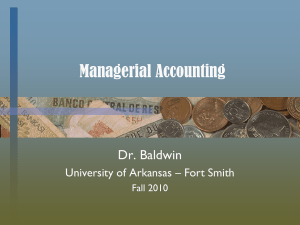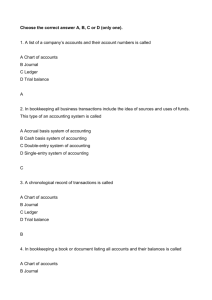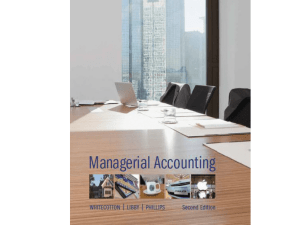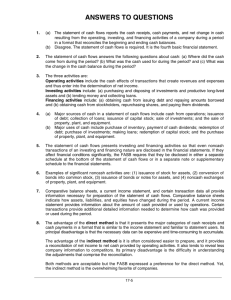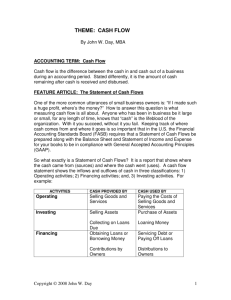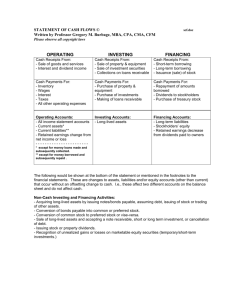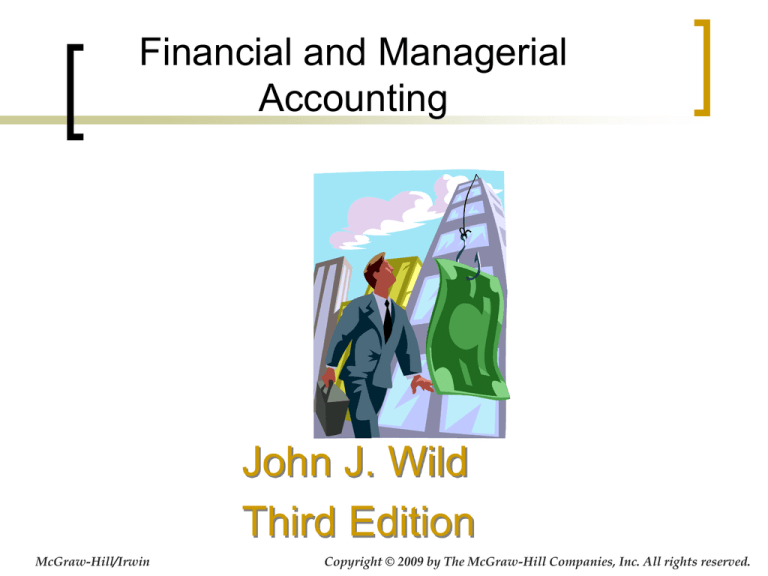
Financial and Managerial
Accounting
John J. Wild
Third Edition
McGraw-Hill/Irwin
Copyright © 2009 by The McGraw-Hill Companies, Inc. All rights reserved.
Chapter 12
Reporting and Analyzing Cash Flows
Conceptual Learning Objectives
C1: Explain the purpose and importance
of cash flow information.
C2: Distinguish between operating,
investing, and financing activities.
C3: Identify and disclose noncash
investing and financing activities.
C4: Describe the format of the statement
of cash flows.
12-3
Analytical Learning Objectives
A1: Analyze the statement of cash flows.
A2: Compute and apply the cash flow on
total assets ratio.
12-4
Procedural Learning Objectives
P1: Prepare a statement of cash flows.
P2: Compute cash flows from operating
activities using the indirect method.
P3: Determine cash flows from both investing
and financing activities.
P4: Appendix 12A: Illustrate use of a
spreadsheet to prepare a statement of
cash flows.
P5: Appendix 12B: Compute cash flows from
operating activities using the direct
method.
12-5
C1
Purpose of the Statement of Cash
Flows
How does a
company obtain its
cash?
Where does a
company spend its
cash?
What explains the
change in the cash
balance?
12-6
A1
Importance of Cash Flows
How did the
business fund its
operations?
Does the business
have sufficient cash
to pay its debts as
they mature?
Did the business
make any dividend
payments?
Did the business
borrow any funds or
repay any loans?
12-7
C1
Measurement of Cash Flows
Cash
Equivalents
Cash
Currency
Short-term, highly liquid investments.
Readily convertible into cash.
Sufficiently close to maturity so that market value is
unaffected by interest rate changes.
12-8
C2
Classifying Cash Flows
•
•
•
The Statement of Cash Flows
includes the following three
sections:
Operating Activities
Investing Activities
Financing Activities
12-9
C2
Operating Activities
•
•
•
•
•
•
•
•
•
Inflows
Receipts from customers
Cash dividends received
Interest from borrowers
Other.
Outflows
Salaries and wages
Payments to suppliers
Taxes and fines
Interest paid to lenders
Other
12-10
C2
Investing Activities
•
•
•
•
•
•
•
•
Inflows
Selling long-term productive
assets
Selling equity investments
Collecting principal on loans
Other
Outflows
Purchasing long-term
productive assets
Purchasing equity
investments
Purchasing debt investments
Other
12-11
C2
Financing Activities
•
•
•
•
•
•
•
Inflows
Issuing its own equity
securities
Issuing bonds and notes
Issuing short- and long-term
liabilities
Outflows
Pay dividends
Purchasing treasury stock
Repaying cash loans
Paying owners’ withdrawals
12-12
Noncash Investing and
Financing
C3
•
•
•
Items requiring separate
disclosure include:
Retirement of debt by issuing
equity securities.
Conversion of preferred stock to
common stock.
Leasing of assets in a capital
lease transaction.
12-13
C4
Format of the Statement of Cash
Flows
Company Name
Statement of Cash Flows
For Period Ended Date
Cash flows from operating activities:
[List of individual inflows and outflows]
Net cash provided (used) by operating activites
Cash flows from investing activities:
[List of individual inflows and outflows]
Net cash provided (used) by investing activites
Cash flows from financing activities:
[List of individual inflows and outflows]
Net cash provided (used) by financing activites
Net increase (decrease) in cash
Cash (and equivalents) balance at beginning of period
Cash (and equivalents) balance at end of period
$ #####
#####
#####
$ #####
#####
$ #####
12-14
C4
Format of the Statement of Cash
Flows
There are two acceptable methods to determine
Cash Flows from Operating Activities:
•Direct Method
•Indirect Method
12-15
P2
Preparing the Statement of Cash
Flows
Let’s look at the Indirect
Method for preparing the
Cash Flows from Operating
Activities section.
12-16
P2
Indirect Method
Changes in current assets
and current liabilities.
Cash Flows
from Operating
Activities
Net
Income
+ Losses and
- Gains
+ Noncash
expenses such as
depreciation and
amortization.
97.5% of all companies use the indirect method.
12-17
Indirect Method
P2
Current
Assets
Current
Liabilities
Change in Account Balance During Year
Increase
Decrease
Subtract from net
Add to net income.
income.
Add to net income.
Subtract from net
income.
Use this table when adjusting Net Income
to Operating Cash Flows.
12-18
Indirect Method Example
P2
East, Inc. reports $125,000 net income for the
year ended December 31, 2009.
Accounts Receivable increased by $7,500
during the year and Accounts Payable
increased by $10,000.
During 2009, East reported $12,500 of
Depreciation Expense.
What is East, Inc.’s Operating
Cash Flow for 2009?
12-19
P2
Indirect Method Example
Net
Netincome
income
$$ 125,000
125,000
Deduct:
Deduct:Increase
Increasein
inaccounts
accounts
For
the
indirect
receivable
receivable
method, start with
Cash
provided
by
Cash
provided
byoperating
operating
net
income.
activities
activities
12-20
P2
Indirect Method Example
Net
Netincome
income
Add:
Add:Depreciation
Depreciationexpense
expense
Deduct:
Deduct:Increase
Increasein
inaccounts
accounts
receivable
Add noncash expenses such
receivable
$$ 125,000
125,000
12,500
12,500
as depreciation, depletion,
amortization,
orby
bad
debt
Cash
provided
Cash
provided
byoperating
operating
expense.
activities
activities
12-21
P2
Indirect Method Example
Net
Netincome
income
Add:
Add:Depreciation
Depreciationexpense
expense
Deduct:
Deduct:Increase
Increasein
inaccounts
accounts
receivable
receivable
$$ 125,000
125,000
12,500
12,500
(7,500)
(7,500)
Change
in
Account Balance During Year
Cash
by
Cashprovided
provided
byoperating
operating
Increase
Decrease
activities
activities
Current
Assets
Current
Liabilities
Subtract from net
income.
Add to net income.
Add to net income.
Subtract from net
income.
12-22
P2
Indirect Method Example
Net
$$ 125,000
Netincome
income
125,000
Add:
12,500
Add:Depreciation
Depreciationexpense
expense
12,500
Deduct:
Deduct:Increase
Increasein
inaccounts
accounts
receivable
(7,500)
receivable
(7,500)
Add:
10,000
Add:Increase
Increasein
inaccounts
accountspayable
payable
10,000
Cash
by
operating
Cashprovided
provided
by
operating
Change in Account Balance During Year
activities
activities
Increase
Decrease
Current
Assets
Current
Liabilities
Subtract from net
income.
Add to net income.
Add to net income.
Subtract from net
income.
12-23
P2
Indirect Method Example
Net
$$ 125,000
Netincome
income
125,000
Add:
12,500
Add:Depreciation
Depreciationexpense
expense
12,500
Deduct:
Deduct:Increase
Increasein
inaccounts
accounts
receivable
(7,500)
receivable
(7,500)
Add:
10,000
Add:Increase
Increasein
inaccounts
accountspayable
payable
10,000
Cash
Cashprovided
providedby
byoperating
operating
activities
$$ 140,000
activities
140,000
If we used the Direct Method, we would get the same
$140,000 for Cash Provided by Operating Activities.
12-24
P2
Indirect Method
Let’s prepare a Statement of
Cash Flows for B&G Company
using the Indirect Method.
12-25
P2
B&G Company
Comparative Balance Sheets
December 31
2009
Assets
Cash
Accounts receivable
Inventories
Land
Equipment
Accumulated depreciation-equipment
Total Assets
Liabilities and Stockholders' Equity
Accounts payable
Bonds payable
Common stock, $1 par
Retained earnings
Total Liabilities and Stockholders' Equity
$
$
$
$
2008
Increase
or
(Decrease)
63,000 $
85,000
170,000
75,000
270,000
(66,000)
597,000 $
22,000 $ 41,000
76,000
9,000
189,000
(19,000)
100,000
(25,000)
200,000
70,000
(32,000)
(34,000)
555,000 $ 42,000
39,000
150,000
209,000
199,000
597,000
47,000
200,000
174,000
134,000
555,000
$
$
(8,000)
(50,000)
35,000
65,000
$ 42,000
12-26
P2
Additional Information for 2009:
• Net income was $105,000.
• Cash dividends declared and paid were
$40,000.
• Bonds payable of $50,000 were redeemed
for $50,000 cash.
• Common stock was issued for $35,000
cash.
12-27
P1
B&G Company
Statement of Cash Flows
For the Year Ended December 31, 2009
Cash flows from operating activities
Net income
Adjustments to accrual-basis net income:
Add noncash expenses and
losses.
Subtract noncash revenues
and gains.
Then, analyze the changes in
current assets and current
liabilities.
$
105,000
Start with
accrual-basis
net income.
12-28
P2
B&G Company
Statement of Cash Flows
For the Year Ended December 31, 2009
Cash flows from operating activities
Net income
$
Adjustments to accrual-basis net income:
Depreciation expense
$
34,000
Increase in accounts receivable
(9,000)
Decrease in inventory
19,000
Decrease in accounts payable
(8,000)
Total adjustments
Net cash provided by operating activities
Cash flows from investing activities
Current
Assets
Current
Liabilities
105,000
36,000
141,000
Change in Account Balance During Year
Increase
Decrease
Subtract from net
Add to net income.
income.
Add to net income.
Subtract from net
income.
12-29
P3
B&G Company
Statement of Cash Flows
For the Year Ended December 31, 2009
Cash flows from operating activities
Net income
$
Adjustments to accrual-basis net income:
Depreciation expense
$
34,000
Increase in accounts receivable
(9,000)
Decrease in inventory
19,000
Decrease in accounts payable
(8,000)
Total adjustments
Net cash provided by operating activities
Cash flows from investing activities
105,000
36,000
141,000
Now, let’s complete the
investing section.
12-30
P3
B&G Company
Statement of Cash Flows
For the Year Ended December 31, 2009
Cash flows from operating activities
Net income
$
Adjustments to accrual-basis net income:
Depreciation expense
$
34,000
Increase in accounts receivable
(9,000)
Decrease in inventory
19,000
Decrease in accounts payable
(8,000)
Total adjustments
Net cash provided by operating activities
Cash flows from investing activities
Proceeds from sale of land
25,000
Purchase of equipment
(70,000)
Net cash used by investing activities
Cash flows from financing activities
105,000
36,000
141,000
(45,000)
Now, let’s complete the
financing section.
12-31
P1
B&G Company
Statement of Cash Flows
For the Year Ended December 31, 2009
Cash flows from operating activities
Net income
$
Adjustments to accrual-basis net income:
Depreciation expense
$
34,000
Increase in accounts receivable
(9,000)
Decrease in inventory
19,000
Decrease in accounts payable
(8,000)
Total adjustments
Net cash provided by operating activities
Cash flows from investing activities
Proceeds from sale of land
25,000
Purchase of equipment
(70,000)
Net cash used by investing activities
Cash flows from financing activities
Proceeds from issuance of common stock
35,000
Redemption of bonds
(50,000)
Payment of dividends
(40,000)
Net cash used by financing activities
Net increase in cash
Cash, January 1, 2009
Cash, December 31, 2009
$
105,000
36,000
141,000
(45,000)
(55,000)
41,000
22,000
63,000
12-32
A1
Analyzing Cash Sources and Uses
Cash Flows of Competing Companies
all numbers in thousands
Cash provided (used) by operating
activities
Cash provided (used) by investing
activities:
Proceeds from sale of operating
assets
Purchase of operating assets
Cash provided (used) by financing
activities:
Proceeds from issuance of debt
Repayment of debt
Net increase (decrease) in cash
BMX
$
90,000
ATV
$
40,000
Trex
$
(24,000)
26,000
(48,000)
(25,000)
13,000
$
(27,000)
15,000 $
15,000
$
15,000
12-33
A2
Cash Flow on Total Assets
Used, along with income-based ratios, to
assess company performance.
Cash flow on
total assets
=
Operating cash flows
Average total assets
12-34
P5
Preparing the Statement of Cash
Flows
Let’s look at the Direct
Method for preparing the
Cash Flows from Operating
Activities section.
12-35
P5
Analyzing the Cash Account
Balance, Jan. 1, 2009
Receipts from customers
Receipts from sale of land
Receipts from stock issuance
Balance, Dec. 31, 2009
Cash
22,000 Payments for merchandise
466,000 Payments for wages
25,000 Payments for interest
35,000 Payments for taxes
Payments for equipment
Payments for bond retirement
Payments for dividends
63,000
150,000
145,000
10,000
20,000
70,000
50,000
40,000
Let’s use this Cash account to prepare B&G
Company’s Statement of Cash Flows under the
Direct Method.
12-36
P5
Preparing the Statement of Cash Flows –
Direct Method
B&G Company
Statement of Cash Flows
For the Year Ended December 31, 2009
Cash flows from operating activities
Cash received from customers
$
466,000
Cash paid for merchandise
(150,000)
Cash paid for wages
(145,000)
Cash paid for interest
(10,000)
Cash paid for taxes
(20,000)
Net cash provided by operating activities
Cash flows from investing activities
Proceeds from sale of land
25,000
Purchase of equipment
(70,000)
Net cash used by investing activities
Cash flows from financing activities
Proceeds from issuance of common stock
35,000
Redemption of bonds
(50,000)
Payment of dividends
(40,000)
Net cash used by financing activities
Net increase in cash
Cash, January 1, 2009
Cash, December 31, 2009
$
141,000
(45,000)
(55,000)
41,000
22,000
63,000
12-37
End of Chapter 12
12-38

